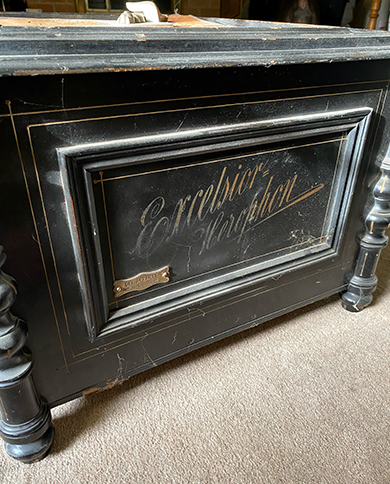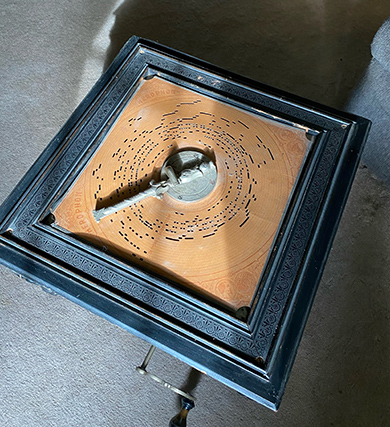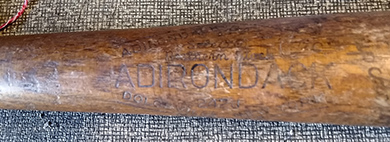 |
|
|||
 |
 |
|||
RINKER ON COLLECTIBLES — Column #1793 Copyright © Harry Rinker, LLC 2021 Questions
and Answers
QUESTION: I have an antique Herophon with 17 records that I inherited from my parents. It was gifted to them by a family member. A metal plaque on the side reads: “OEL APPARAT / ANWEISGUNG SIEHEN.” record titles include “Come, Birdie, Come,” “Put a Sponge on Polka, and “Shadow Dance.” I have no idea of its background or what it is worth. I would like to sell it. – JT, Email Question 
ANSWER: Ch. F. Pietschmann & Söhne, a German company, received a patent for the Herophon, a hand-cranked table-top organette, in 1883. The Herophon is a music box with non-traditional features. Unlike other disc music boxes of its time, the disc on the Herophon remained stationary. A 24-note reed organ movement revolves beneath the disc. A pressure arm keeps the disc in place. The discs are square in shape, 35mm, as opposed to the round discs used in traditional disc music boxes. The holes in the square disc are cut in a circular pattern. The Herophon discs are made of a stiff paper with metal reinforcing strips around the edges. A few metal disks also were manufactured. A smaller model called the Herophonette used 26mm discs. Paul Erhlich & Co. filed a patent infringement suit against Ch. F. Pietschmann & Söhne claiming that the Herophon was similar to its Ariston organette. The case lasted from 1885 to 1888. Ehrlich won the case. As a result, Herophon organettes produced after 1888 were made by Paul Erhlich & Co. By 1890, the company was known as Fabrik Leipziger Musikwerke. Erhlich patented the Herophon in the Austria, Great Britain, United States (25745), and “andere Lander” (other lands). The Organette Music Repository (www.organettes.com/instruments/herophon/home) website contains a list of disc titles taken from Kevin McElhone’s “The Organette Book.” Disc numbers ranged as high as 4751, albeit the majority were under 2306. The list is not complete. I did not find any of the three discs titles you own on the list. The literal translation of the metal plaque is: “Oil the apparatus / See the instructions.” Several internet auction sites indicate the Herophon was made into the first decade of the 21st century. Sell through prices ranged from $500.00 to $750.00. The range can be explained based on condition (playability), case and manufacturer variations, and number of discs accompanying the Herophon. Individual discs in playable condition sell through at auction between $25.00 and $30.00 each, albeit music box dealers ask higher prices. Although the Herophon was patented and sold in the United States, its primary secondary market is in Europe, especially Germany. Auction Team Breker (PO Box 50 11 19, 50971 Köln, Germany) specializes in technical antiques and fine toys. The firm has an American representative, Andrew Truman, who can be reached at (207) 485-8384 or andrewauctionteambreker@gmail.com. Bonhams and Christie’s sold Herophon organettes in the past. If you approach these auction houses, make it clear you would like the Herophon to be sold at one of their European auction sites. 
QUESTION: I have a baseball bat that measures 30” in length. I suspect it is from 1960 to 1962 when I played Little League. The logo on the bat reads “ADIRONDACK BATS, INC. / Northern / White Oak / ADIRONDACK / 2420 / DOLGEVILLE NEW YORK.” To the right of logo is a script “Flexible / Whip Action.” The model name is worn off. It might be Hodges or Killebrew. I moved up to a 33- or 34-inch bat when I played JR League and American Legion ball. Does my bat have value? – SD, Landsdale, PA, Email Question 
ANSWER: Edwin McLaughlin established a small sawmill and woodworking shop in Dolgeville, New York prior to World War II. The sawmill produced dimension stock for woodworking and billets for the production of baseball bats. In 1945, Charles Millard partnered with McLaughlin. In 1946, they marketed their first McLaughlin Millard, Inc. Adirondack baseball bat. It was made from Northern white ash. Ash was used until 1958 when Northern white oak replaced it. Hal Schumacker, a former New York Giants pitcher, joined the firm as manager for dealer and professional sales. In June 1969, Evan Baker became president of Adirondack. Baker created the Bat-mobile, an Airstream camper that was equipped to hand turn bats at Major League Baseball spring-training camps. Several Major League players such as Tony Oliva and Joe Torre became fans of Adirondack’s “Big Stick.” During the 1977 World Series between the New York Yankees and the Los Angeles Dodgers, Reggie Jackson hit three consecutive home runs in the sixth game using a “Big Stick” bat. Rawlings Sporting Goods merged with Adirondack in June of 1975. It continued to produce Adirondack models. The website www.keymancollectibles.com features an Adirondack Bat Dating Guide. Bats are dated by the changing logo found on the bat. The website indicates that your bat was made between 1958 and 1960s. Perhaps you acquired it used rather than new when you played Little League baseball. Your Adirondack bat is in poor condition. It was heavily used. The lack of an endorsement signature is a major deterrent. I had trouble finding reliable sell-through information for Adirondack bats in your condition and size. Most of the listings I found were for bats autographed by the player who endorsed them. Value for these bats is based on the fame or lack thereof of the player who signed it. The value of your bat is the personal memories it holds for you. A dollar or two at a garage or yard sale is a fair secondary market price. QUESTION: I have 13 Sebastian miniatures that belonged to my mother. Some have been signed by Prescott W. Baston. How do I determine what they are worth? –LH, Email Question 
ANSWER: Sebastian miniatures are a series of small ceramic sculptural figures that were produced by Prescott Woodbury Baston, Sr., of Arlington, Massachusetts starting in 1938. The figures ranged from historical personalities such as George Washington to scenes from life involving children and families. Baston moved his studio to Marblehead, Massachusetts in 1946 and to Hudson, Massachusetts in 1976. Baston died in 1984. Lance Corporation marketed the figures between 1976 and 1997. Preston W. Baston, Jr., started modeling figures in the 1980s. Chances are the signature on your pieces is that of Baston, Jr. rather than that of his father. There are more than 400 figures in the Sebastian line. The first step is to obtain a copy of Robert A. Edmund’s and Preston W. Baston, Jr.’s “The Sebastian Miniatures Gold Book of Information and Values,” published by Sebastianworld in 2000, and use it to identify the names of your figures. If you cannot find a used copy online at a reasonable cost, ask your local library to get you a copy using the Interlibrary Loan system. Ignore the values found in any printed Sebastian price guide. Once you know the name of your figures, you can start researching prices online. The pictures that accompanied your email were badly out of focus. Using WorthPoint.com’s Worthopedia, which has more than 9,000 listings for Sebastian miniatures, I tried to identify one or two of your figures. I found the boy with the sailboat in a Worthopedia listing for a lot of five Sebastian figures sold on eBay on July 20, 2020, for $20.00; $4.00 per figure. Your covered bridge Sebastian figure sold through on eBay on February 20, 2021, for $9.00. The secondary market, especially for recent Sebastian figures, is in the doldrums, a fact I do not see changing any time in the future. An offer of $5.00 a figure would be most generous.
Harry L. Rinker welcomes questions from readers about
collectibles, those mass-produced items from the twentieth and twenty-first centuries.
Selected letters will be answered in this column.
Harry cannot provide personal answers.
Photos and other material submitted cannot be
returned.
Send your questions to: Rinker on Collectibles, 5955 Mill
Point Court SE, Kentwood, MI 49512.
You also can e-mail your questions to
harrylrinker@aol.com.
Only e-mails containing a full name and mailing address
will be considered.
|
||||